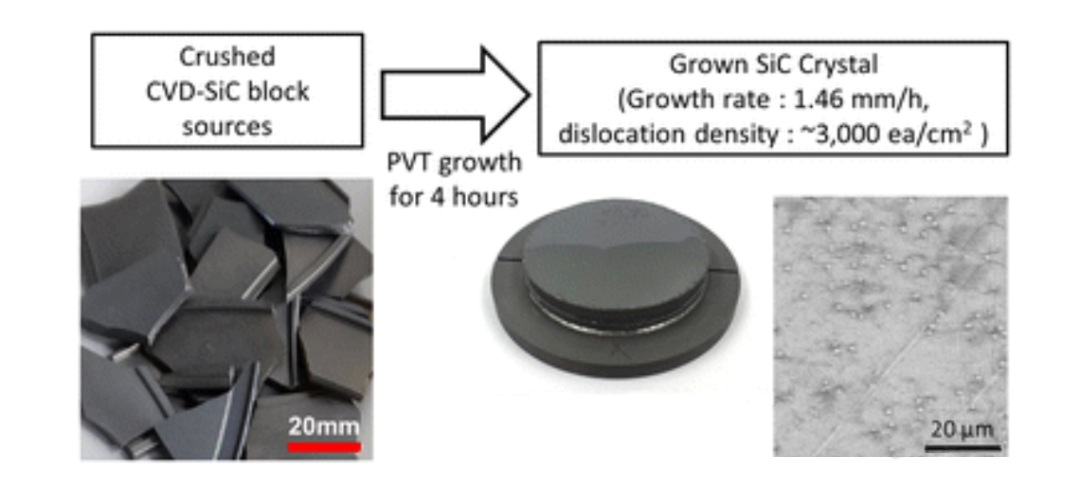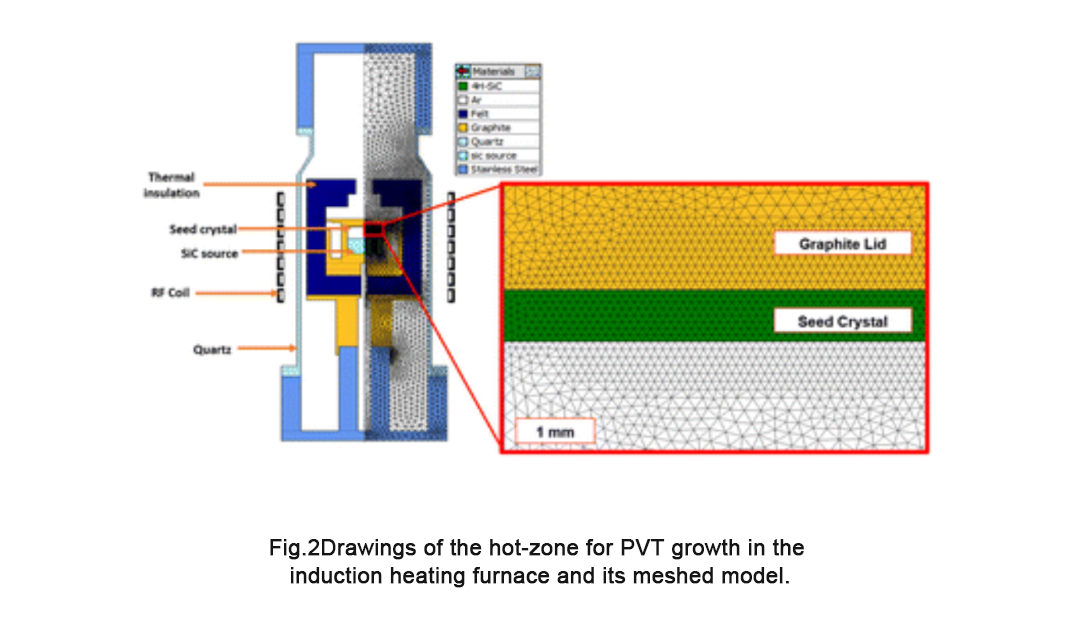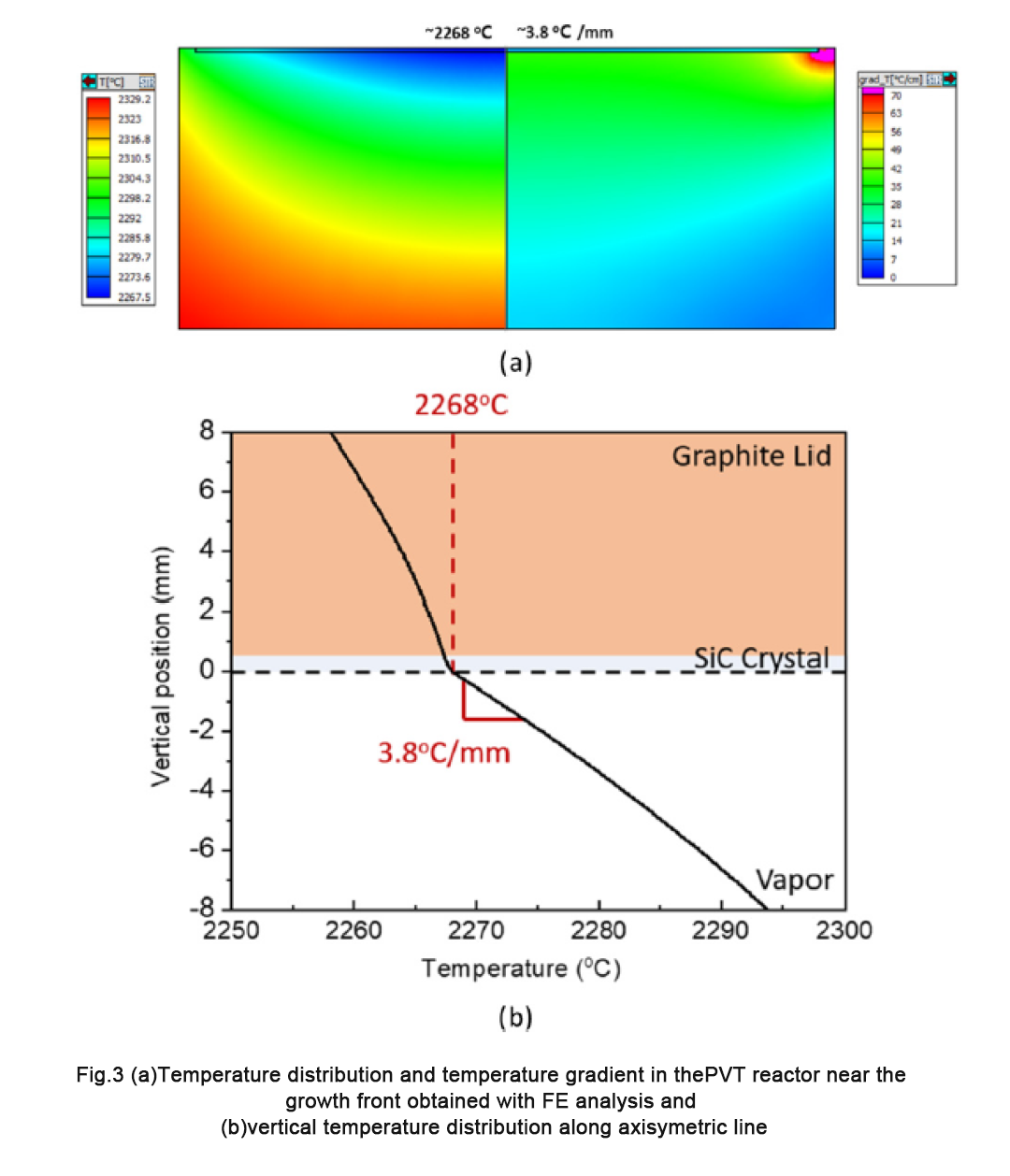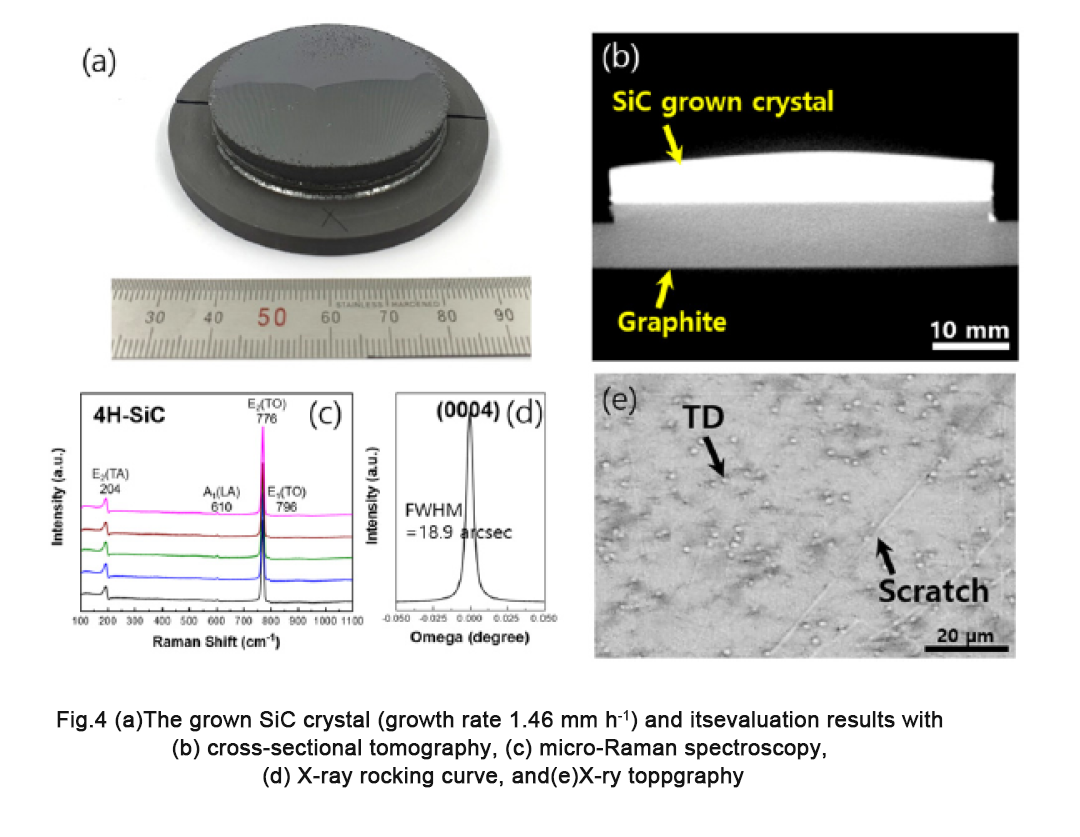Rapid Growth of SiC Single Crystal Using CVD-SiC Bulk Source via Sublimation Method
By using recycled CVD-SiC blocks as the SiC source, SiC crystals were successfully grown at a rate of 1.46 mm/h through the PVT method. The grown crystal’s micropipe and dislocation densities indicate that despite the high growth rate, the crystal quality is excellent.

Silicon carbide (SiC) is a wide-bandgap semiconductor with excellent properties for applications in high voltage, high power, and high frequency. Its demand has grown rapidly in recent years, especially in the power semiconductor field. For power semiconductor applications, SiC single crystals are grown by sublimating high-purity SiC source at 2100–2500°C, then recrystallizing onto a seed crystal using the physical vapor transport (PVT) method, followed by processing to obtain single crystal substrates on wafers. Traditionally, SiC crystals are grown using the PVT method at a growth rate of 0.3 to 0.8 mm/h to control crystallinity, which is relatively slow compared to other single crystal materials used in semiconductor applications. When SiC crystals are grown at high growth rates using the PVT method, quality degradation including carbon inclusions, reduced purity, polycrystalline growth, grain boundary formation, and dislocation and porosity defects has not been ruled out. Therefore, rapid growth of SiC has not been developed, and the slow growth rate of SiC has been a major obstacle to the productivity of SiC substrates.

On the other hand, recent reports on rapid growth of SiC have been using high-temperature chemical vapor deposition (HTCVD) methods rather than the PVT method. The HTCVD method uses a vapor containing Si and C as the SiC source in the reactor. HTCVD has not yet been used for large-scale production of SiC and requires further research and development for commercialization. Interestingly, even at a high growth rate of ∼3 mm/h, SiC single crystals can be grown with good crystal quality using the HTCVD method. Meanwhile, SiC components have been used in semiconductor processes under harsh environments that require extremely high purity process control. For semiconductor process applications, ∼99.9999% (∼6N) purity SiC components are usually prepared by the CVD process from methyltrichlorosilane (CH3Cl3Si, MTS). However, despite the high purity of CVD-SiC components, they have been discarded after use. Recently, discarded CVD-SiC components have been considered as SiC sources for crystal growth, although some recovery processes including crushing and purification are still required to meet the high demands of a crystal growth source. In this study, we used discarded CVD-SiC blocks to recycle materials as a source for growing SiC crystals. The CVD-SiC blocks for single crystal growth were prepared as size-controlled crushed blocks, significantly different in shape and size compared to the commercial SiC powder commonly used in the PVT process, hence the behavior of SiC single crystal growth was expected to be significantly different. Before conducting SiC single crystal growth experiments, computer simulations were performed to achieve high growth rates, and the thermal zone was configured accordingly for single crystal growth. After crystal growth, the grown crystals were evaluated by cross-sectional tomography, micro-Raman spectroscopy, high-resolution X-ray diffraction, and synchrotron white beam X-ray topography.
Figure 1 shows the CVD-SiC source used for PVT growth of SiC crystals in this study. As described in the introduction, CVD-SiC components were synthesized from MTS by the CVD process and shaped for semiconductor use through mechanical processing. N was doped in the CVD process to achieve conductivity for semiconductor process applications. After use in semiconductor processes, the CVD-SiC components were crushed to prepare the source for crystal growth, as shown in Figure 1. The CVD-SiC source was prepared as plates with an average thickness of ∼0.5 mm and an average particle size of 49.75 mm.
 Figure 1: CVD-SiC source prepared by the MTS-based CVD process.
Figure 1: CVD-SiC source prepared by the MTS-based CVD process.
Using the CVD-SiC source shown in Figure 1, SiC crystals were grown by the PVT method in an induction heating furnace. To evaluate the temperature distribution in the thermal zone, commercial simulation code VR-PVT 8.2 (STR, Republic of Serbia) was used. The reactor with the thermal zone was modeled as a 2D axisymmetric model, as shown in Figure 2, with its mesh model. All materials used in the simulation are shown in Figure 2, and their properties are listed in Table 1. Based on the simulation results, SiC crystals were grown using the PVT method at a temperature range of 2250–2350°C in an Ar atmosphere at 35 Torr for 4 hours. A 4° off-axis 4H-SiC wafer was used as the SiC seed. The grown crystals were evaluated by micro-Raman spectroscopy (Witec, UHTS 300, Germany) and high-resolution XRD (HRXRD, X’Pert-PROMED, PANalytical, Netherlands). The impurity concentrations in the grown SiC crystals were evaluated using dynamic secondary ion mass spectrometry (SIMS, Cameca IMS-6f, France). The dislocation density of the grown crystals was evaluated using synchrotron white beam X-ray topography at the Pohang Light Source.
 Figure 2: Thermal zone diagram and mesh model of PVT growth in an induction heating furnace.
Figure 2: Thermal zone diagram and mesh model of PVT growth in an induction heating furnace.
Since HTCVD and PVT methods grow crystals under gas-solid phase equilibrium at the growth front, successful rapid growth of SiC by the HTCVD method prompted the challenge of rapid growth of SiC by the PVT method in this study. The HTCVD method uses a gas source that is easily flow-controlled, while the PVT method uses a solid source that does not directly control flow. The flow rate provided to the growth front in the PVT method can be controlled by the sublimation rate of the solid source through temperature distribution control, but precise control of the temperature distribution in practical growth systems is not easy to achieve.
By increasing the source temperature in the PVT reactor, the growth rate of SiC can be increased by increasing the sublimation rate of the source. To achieve stable crystal growth, temperature control at the growth front is crucial. To increase the growth rate without forming polycrystals, a high-temperature gradient needs to be achieved at the growth front, as shown by SiC growth via the HTCVD method. Inadequate vertical heat conduction to the back of the cap should dissipate the accumulated heat at the growth front through thermal radiation to the growth surface, leading to the formation of excess surfaces, i.e., polycrystalline growth.
Both mass transfer and recrystallization processes in the PVT method are very similar to the HTCVD method, although they differ in the SiC source. This means that rapid growth of SiC is also achievable when the sublimation rate of the SiC source is sufficiently high. However, achieving high-quality SiC single crystals under high growth conditions via the PVT method has several challenges. Commercial powders typically contain a mixture of small and large particles. Due to surface energy differences, small particles have relatively high impurity concentrations and sublimate before large particles, leading to high impurity concentrations in the early growth stages of the crystal. Additionally, as solid SiC decomposes into vapor species like C and Si, SiC2 and Si2C at high temperatures, solid C inevitably forms when the SiC source sublimates in the PVT method. If the formed solid C is small and light enough, under rapid growth conditions, small C particles, known as “C dust,” can be transported to the crystal surface by strong mass transfer, resulting in inclusions in the grown crystal. Therefore, to reduce metal impurities and C dust, the particle size of the SiC source should generally be controlled to a diameter of less than 200 μm, and the growth rate should not exceed ∼0.4 mm/h to maintain slow mass transfer and exclude floating C dust. Metal impurities and C dust lead to the degradation of grown SiC crystals, which are the main obstacles to the rapid growth of SiC via the PVT method.
In this study, crushed CVD-SiC sources without small particles were used, eliminating floating C dust under strong mass transfer. Thus, the thermal zone structure was designed using multiphysics simulation-based PVT method to achieve rapid SiC growth, and the simulated temperature distribution and temperature gradient are shown in Figure 3a.
Figure 3: (a) Temperature distribution and temperature gradient near the growth front of the PVT reactor obtained by finite element analysis, and (b) vertical temperature distribution along the axisymmetric line.
Compared to typical thermal zone settings for growing SiC crystals at a growth rate of 0.3 to 0.8 mm/h under a small temperature gradient of less than 1 °C/mm, the thermal zone settings in this study have a relatively large temperature gradient of ∼3.8 °C/mm at a growth temperature of ∼2268°C. The temperature gradient value in this study is comparable to the rapid growth of SiC at a rate of 2.4 mm/h using the HTCVD method, where the temperature gradient is set to ∼14 °C/mm. From the vertical temperature distribution shown in Figure 3b, we confirmed that no reverse temperature gradient that could form polycrystals was present near the growth front, as described in the literature.
Using the PVT system, SiC crystals were grown from the CVD-SiC source for 4 hours, as shown in Figures 2 and 3. A representative SiC crystal growth from the grown SiC is shown in Figure 4a. The thickness and growth rate of the SiC crystal shown in Figure 4a are 5.84 mm and 1.46 mm/h, respectively. The impact of the SiC source on the quality, polytype, morphology, and purity of the grown SiC crystal shown in Figure 4a was investigated, as shown in Figures 4b-e. The cross-sectional tomography image in Figure 4b shows that the crystal growth was convex-shaped due to the suboptimal growth conditions. However, the micro-Raman spectroscopy in Figure 4c identified the grown crystal as a single phase of 4H-SiC without any polytype inclusions. The FWHM value of the (0004) peak obtained from the X-ray rocking curve analysis was 18.9 arcseconds, also confirming good crystal quality.
Figure 4: (a) Grown SiC crystal (growth rate of 1.46 mm/h) and its evaluation results with (b) cross-sectional tomography, (c) micro-Raman spectroscopy, (d) X-ray rocking curve, and (e) X-ray topography.
Figure 4e shows the white beam X-ray topography identifying scratches and threading dislocations in the polished wafer of the grown crystal. The dislocation density of the grown crystal was measured to be ∼3000 ea/cm², slightly higher than the dislocation density of the seed crystal, which was ∼2000 ea/cm². The grown crystal was confirmed to have relatively low dislocation density, comparable to the crystal quality of commercial wafers. Interestingly, rapid growth of SiC crystals was achieved using the PVT method with a crushed CVD-SiC source under a large temperature gradient. The concentrations of B, Al, and N in the grown crystal were 2.18 × 10¹⁶, 7.61 × 10¹⁵, and 1.98 × 10¹⁹ atoms/cm³, respectively. The concentration of P in the grown crystal was below the detection limit (<1.0 × 10¹⁴ atoms/cm³). The impurity concentrations were sufficiently low for charge carriers, except for N, which was intentionally doped during the CVD process.
Although the crystal growth in this study was small-scale considering commercial products, the successful demonstration of rapid SiC growth with good crystal quality using the CVD-SiC source through the PVT method has significant implications. Since CVD-SiC sources, despite their excellent properties, are cost-competitive by recycling discarded materials, we expect their widespread utilization as a promising SiC source to replace SiC powder sources. To apply CVD-SiC sources for rapid growth of SiC, optimizing the temperature distribution in the PVT system is required, posing further questions for future research.
Conclusion
In this study, the successful demonstration of rapid SiC crystal growth using crushed CVD-SiC blocks under high-temperature gradient conditions through the PVT method was achieved. Interestingly, the rapid growth of SiC crystals was realized by replacing the SiC source with the PVT method. This method is expected to significantly increase the large-scale production efficiency of SiC single crystals, ultimately reducing the unit cost of SiC substrates and promoting the widespread use of high-performance power devices.
Post time: Jul-19-2024


